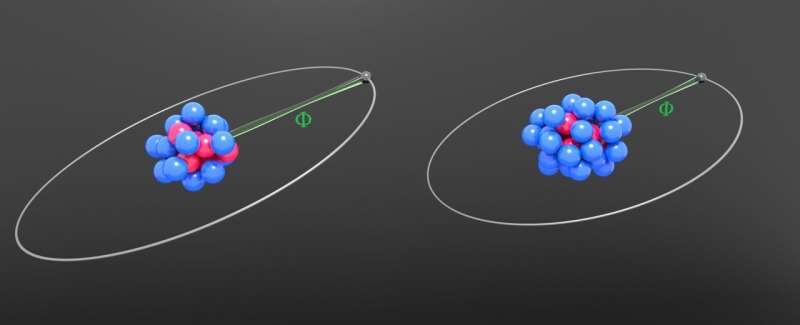Study Enhances Constraints on Hypothetical Fifth Force Using King Plot Analysis

June 23, 2025 feature
by Ingrid Fadelli, Phys.org
contributing writer
edited by Sadie Harley, reviewed by Robert Egan
scientific editor
associate editor
This article has been reviewed according to Science X's editorial process and policies. Editors have highlighted the following attributes while ensuring the content's credibility:
fact-checked
peer-reviewed publication
trusted source
proofread
While the Standard Model (SM) describes all known fundamental particles and many of the interactions between them, it fails to explain dark matter, dark energy and the apparent asymmetry between matter and antimatter in the universe. Over the past decades, physicists have thus introduced various frameworks and methods to study physics beyond the SM, one of which is known as the King plot.
The King plot is a graphical technique used to analyze isotope shifts, variations in the energy levels of different isotopes (e.g., atoms of the same element that contain a different number of neutrons). This graphical tool has proved promising for separating effects explained by the SM from signals linked to new physics.
Researchers at Physikalisch-Technische Bundesanstalt, Max Planck Institute for Nuclear Physics, and ETH Zurich recently collected new measurements that tightened King plot-based constraints on the properties of a hypothetical particle that has not yet been observed, known as a Yukawa-type boson.
Their paper, published in Physical Review Letters, further highlights the potential of isotope shift spectroscopy and the King plot technique for testing particle physics theories and searching for physics outside the SM.
'Back in 2015, my group performed isotope shift measurements on broad, dipole-allowed transitions in Ca+ with 100 kHz uncertainty using a new technique (photon recoil spectroscopy) that we had developed earlier,' Piet O. Schmidt, senior author of the paper, told Phys.org.
'A couple of years later this data was used by a collaboration at the Weizmann Institute in Israel to put bounds on a hypothetical fifth force. It was clear that the bounds could be significantly improved using narrow transitions in calcium isotopes, in particular when combining transitions from different charge states.
'José Crespo and his group performed the first in-EBIT measurements on Ca14+ and determined the sensitivity to new physics that helped my group to find the transitions using quantum logic spectroscopy and measure the isotope shift down to the 100 mHz level.'
In 2023, around the same time as Crespo and his research team performed the first measurements of Ca14+ inside an electron beam ion trap, Schmidt and his colleagues learned about the efforts of another team led by Diana Aude Craik, involving researchers in Jonathan Home's group at ETH.
Craik was re-measuring the isotope shifts of the Ca+ clock transition (i.e., performing more precise measurements of this isotope shift in five isotopes, on a specific optical transition typically leveraged to develop optical atomic clocks).
'By co-trapping isotope pairs, we performed a direct, differential measurement of the isotope shift, eliminating the main sources of experimental noise that affect both ions, to improve the measurement precision by two orders of magnitude,' explained Luca Huber, a graduate student at ETH who is one of the co-first authors of the study.
'This was the first time a nonlinearity was seen in a calcium King plot,' added Craik.
'King plots had been previously made in calcium even down to approximately 10 Hz measurement precision. Our group at ETH improved the measurement precision of the transition in Ca+ to 100 mHz, and Piet's group achieved a similar precision in Ca14+. This, combined with Klaus Blaum's improvement in the precision of the nuclear mass ratios, allowed us to make a sub-Hz King plot, which finally revealed the nonlinearity.'
Discover the latest in science, tech, and space with over 100,000 subscribers who rely on Phys.org for daily insights. Sign up for our free newsletter and get updates on breakthroughs, innovations, and research that matter—daily or weekly.
In an earlier paper published in 2017, Fuchs used isotope shift spectroscopy to establish bounds on a hypothetical fifth force (i.e., a new fundamental interaction between particles that is not yet known).
As part of their recent study, Schmidt and Fuchs established a new collaboration involving Craik and various other experts in various areas of physics, including precision optical spectroscopy and mass spectrometry, atomic and nuclear structure theory and high energy physics, with the aim of further tightening constraints on this fifth hypothetical force.
'We asked Craik to join our collaboration and had already contacted Klaus Blaum about an improved measurement of the nuclear masses, since we knew that we would otherwise be limited by their uncertainty,' said Schmidt.
'Elina Fuchs from Leibniz University in Hannover was taking the lead in the interpretation of the data in the form of an exclusion plot and coordinated the consortium, that was complemented by other theory colleagues working on atomic and nuclear structure calculations of higher-order standard model effects.'
As part of their new collaboration, Schmidt and his colleagues combined their measurements of isotope shifts of the Ca+ and Ca14+ clock transitions. The isotope shift of a transition depends on two key factors, namely differences in the distribution of nuclear charge and differences in nuclear mass.
'The dependence on the change in nuclear size can be eliminated by measuring two transitions,' explained Fuchs.
'This results in a linear dependence between the mass-normalized isotope shift of the two transitions, called a King plot. A hypothetical fifth force would break that linearity, but so would higher-order standard model contributions. We've observed a nonlinearity of more than 1000 standard deviations.
'Highly accurate calculations of the second order mass shift allowed us to subtract its contribution. Theory estimates indicate that the large remaining nonlinearity could be caused by nuclear polarizability, which currently cannot be calculated with high accuracy.'
The new measurements performed by the collaboration could help to improve nuclear models of an effect known as nuclear polarizability, which entails the distortion of an atomic nucleus by electromagnetic fields. Moreover, the researchers were able to add a third transition to the King plot that had been previously measured by different research groups at 6 to 20 Hz precision. This narrowed the parameter space for Yukawa-type interactions, which could be a hypothetical fifth force.
'By adding a third transition to the King plot, we could remove further standard model contributions and obtain the most stringent King plot-based bound on the existence of a fifth force coupling neutrons to electrons,' said Fuchs.
'Our study has shone light on the importance of the nuclear polarizability as a sizable contribution to high accuracy isotope shift measurements.'
The researchers hope that their study will inspire new nuclear physics studies focusing on nuclear polarizability, which could further enrich the present understanding of nuclear physics. Meanwhile, they plan to perform increasingly precise spectroscopy measurements that could set even more stringent King plot-based constraints on a possible fifth force beyond the SM.
Craik and her colleagues at ETH are now measuring the third transition included in the analysis at higher accuracy, aiming at a precision of 10 mHz. This measurement could pave the way for even more targeted searches for interactions beyond the SM.
'This measurement will help us determine whether the nuclear polarizability contribution can be 'factored out' by making a higher-dimensional King plot with more transitions,' said Craik.
'If we find that this contribution can be eliminated by experiment alone, the challenges of calculating this nuclear effect would no longer prevent us from pushing the new-physics sensitivity of isotope-shift spectroscopy into unexplored phase space.'
Written for you by our author Ingrid Fadelli, edited by Sadie Harley , and fact-checked and reviewed by Robert Egan —this article is the result of careful human work. We rely on readers like you to keep independent science journalism alive. If this reporting matters to you, please consider a donation (especially monthly). You'll get an ad-free account as a thank-you.
More information: Alexander Wilzewski et al, Nonlinear Calcium King Plot Constrains New Bosons and Nuclear Properties, Physical Review Letters (2025). DOI: 10.1103/PhysRevLett.134.233002.
Journal information: Physical Review Letters
© 2025 Science X Network




